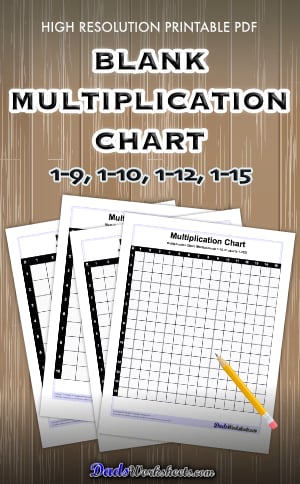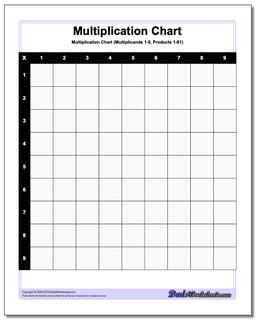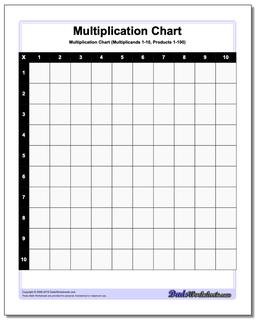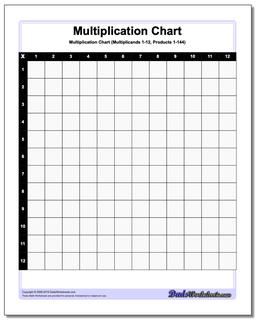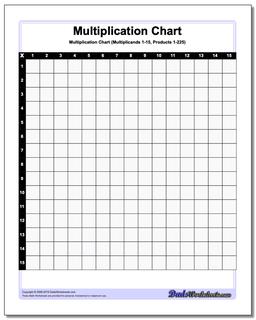Core Math Worksheets
Fraction Worksheets
Word Problems
Algebra and Trigonometry
Other Worksheets
Place Value
Percentages
Rounding Numbers
Ordering Numbers
Standard, Expanded, Word Form
Mean Median Mode Range
Ratio Worksheets
Probability Worksheets
Roman Numerals
Factorization, GCD, LCM
Prime and Composite Numbers
Pre-Algebra
Geometry Worksheets
Blank Clocks
Telling Analog Time
Analog Elapsed Time
Greater Than and Less Than
Money
Arithmetic Sequences
Geometric Sequences
Venn Diagram
Graph Worksheets
Measurement & Conversions
Patterns and Puzzles
Color by Number
Holiday & Seasonal
Early Learning
Printables
Calculators
Multiplication Chart: Blank Multiplication Chart
Each blank multiplication chart in this section allows students to fill in their own set of multiplication facts for reference. There are different variations of each multiplication chart with facts from 1-9 (products 1-81), 1-10 (products 1-100), 1-12 (products 1-144) and 1-15 (products 1-255).
Blank Multiplication Chart (1-9, 1-10, 1-12, 1-15)
Printable Blank Multiplication Chart
These blank multiplication charts can be a good introductory activity for third grade students who can use skip counting to fill in the chart for use as a reference aide on multiplication worksheets or other multiplication activities. You may want to also print one of the complete multiplication charts to allow students to check their work before using their filled-in chart... The only thing worse than not knowing the multiplication tables is memorizing the wrong multiplication facts! :-)
If you are looking for more variety, be sure to check out some of the dozens of other versions at the main multiplication chart page!
Fun Activities Using Blank Multiplication Chart
A blank multiplication chart is one of the mostly widely used tools for mastering multiplication and developing number sense. You can effectively do this through constant practice and incorporating fun activities until your students have memorized the chart. By filling in the chart in various ways, students not only practice basic multiplication facts but also uncover patterns and relationships between numbers. In here, I will briefly discuss some effective exercises to make the most of a blank multiplication chart:
Fill in the Blanks
What is the first exercise that comes to mind when thinking of ways to do an activity that involves a blank multiplication chart? Yes, fill in the blanks! Start with a blank multiplication chart and challenge your students to fill in the products of different number pairs that they can recall. Once the chart is partially filled, tell them to apply the multiplication rules. The Commutative Property for instance means they only need to calculate each product once and can mirror the result in the opposite cell. For example, if 4×6=24, that means 6x4=24 too. Fill in 24 in the appropriate cells. Continue this process for all the other cells that involves the commutative property of multiplication. Moving forward, ask the students to use patterns to identify and verify products. For example, the row for 5 will always end in 5 or 0 (5, 10, 15, 20 etc.) or products involving even numbers are always even, while products involving odd numbers may be odd or even depending on the other factor.
Timed Drills
Turn the previous activity into a timed drill. Timed drill exercises are excellent for building quick recall skills and improving one’s speed and accuracy in multiplication. Set a timer for a few minutes and see how many products each student can fill in correctly. Start with a reasonable time, such as 10 minutes for a 1-9 chart, and adjust based on skill level. Ensure students keep track of the time spent and aim to complete as many questions or fill in as many cells as possible within the allotted time. Review the completed charts then identify and discuss any errors or missed patterns. Conduct the drill again after a period of practice to see improvements in speed and accuracy. As students improve, increase complexity of the drill by gradually reducing the time limit to increase speed (If you started at a 10-minute timer, change the limit to 8 minutes) and test how quickly participants can perform under pressure.
Challenge with Larger Numbers
Expand the completixity of the activity and let the students advance by using larger numbers or extending the chart beyond the typical 10x10 or 12x12 grid. For example, fill out a 30x30, 50x50, or even a 100x100 multiplication chart. Using larger numbers on a blank multiplication chart can be a valuable exercise for advanced practice and will surely challenge each student to apply multiplication skills in a broader context. I suggest you do this especially if you think the kids are starting to get bored filling in a typical chart after several drills.
Games and Competitions
Once the students have mastered filling in the chart under the pressure of having a limited time, another fun way to make learning multiplication fun is by turning it into a game or competition. Challenge your students to see who can fill in the most cells correctly in a set amount of time. You can ask two students to compete with each other or group the entire class into teams. Ask them to discuss strategies before starting the game. This adds a social and competitive element to the exercise and can encourage collaboration and peer learning. Again, adjust the complexity of the game based on the skill level of the participants and encourage friendly competition and teamwork. Lastly, don’t forget to prepare small prizes or certificates for winners to add an element of fun and motivation.
Tournament
You can turn this little competition into a tournament for more excitement too. I’m sure the kids will love it! Emphasize that the goal is to learn and practice multiplication skills while having fun. First, divide the whole class into teams. If the class is large, you might want to break them into smaller groups or pairs. Let them choose a name for their team. Encourage the students to collaborate ideas and practice at home to increase their chances of winning the tournament. Create a schedule for when each round or match will take place. Tailor the difficulty of the problems to the skill level of the students to keep the game challenging yet achievable. Once the tournament is over, announce the winners and distribute any prizes or certificates. After the tournament, review what went well and what could be improved for future tournaments. Consider asking students for feedback on how they felt about the activity.
More Multiplication Charts
If you are looking for more variety or other blank multiplication charts with larger range of products beyond facts from 1-15, be sure to check out the main multiplication chart page! You'll find lots of other options including a complete multiplication chart in black and white and colored versions, cool themed multiplication charts, multiplication charts with different ranges of products and much more…
